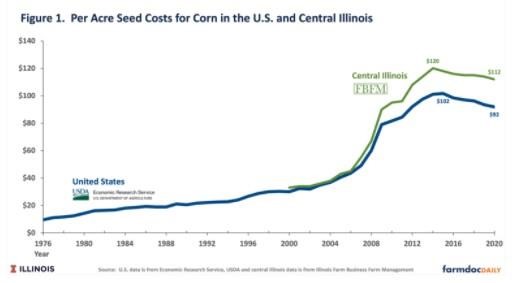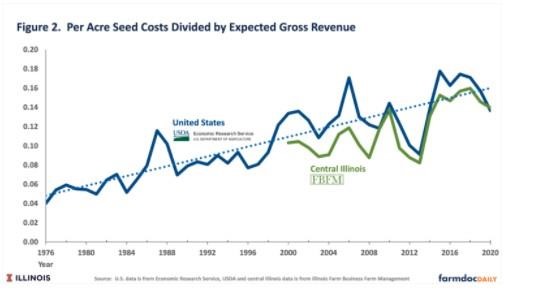By Gary Schnitkey and Nick Paulson et.al
Department of Agricultural and Consumer Economics
University of Illinois
Carl Zulauf
Department of Agricultural, Environmental and Development Economics
Ohio State University
Seed costs for corn have trended up over time. Genetic improvements and biotechnology use in hybrids have led to higher yields, contributing to the general increases in seed prices and per acre seed costs. Seed costs also are positively associated with increases in expected revenue from corn production. As a result, per acre seed costs in the U.S. likely will increase in 2022.
Seed Costs per Acre
Figure 1 shows per acre seed costs for corn from two sources. The blue line provides seed costs for the entire United States and is prepared by the Economic Research Service (ERS), an agency of the U.S. Department of Agriculture. The green line shows per acre seed costs incurred by central Illinois farmers enrolled in Illinois Farm Business Farm Management (FBFM).

These costs come from two independent sources using different data collection methods. As shown in Figure 1, per acre seed costs from USDA and FBFM follow each other closely. For the years in which both sources give data — 2000 through 2020 — the correlation coefficient between the two series is very high. Farms in central Illinois have higher per acre seed costs, most likely due to higher yield potential in central Illinois compared to the U.S. For example, the trend yield represents a pre-growing condition forecast of yields (see farmdoc daily, April 27, 2021 for an explanation of trend yields). In 2020, the expected yield for FBFM farms in central Illinois was 220 bushels per acre, compared to 174 bushels per acre for the U.S.
Three periods of seed costs are evident in Figure 1. From 1975 to 2005, per acre seed costs increased steadily, with an average per acre increase in the U.S. of $1.13 per year.
During the second period from 2006 to 2013, corn prices rose due to the increasing use of corn in producing ethanol. As a result, expected corn revenue reached higher levels, and per acre seed costs increased. In the U.S., seed costs increased from $44 per acre in 2006 to $102 per acre in 2015, an average yearly increase of $6.50 per acre.
The third period constituted a lower commodity price period, corresponding with leveling growth of corn use in ethanol. During the 2015 to 2020 period, seed costs declined slightly from $102 in 2015 to $92 in 2020.
Corn prices moved higher in late 2020 and have persisted through 2021. Historical relationships would suggest that those higher corn prices could lead to higher seed costs in 2022.
Historical Relationships Explaining Per Acre Seed Costs
A statistical evaluation was conducted to determine the factors impacting per acre seed costs in the United States. U.S. data were used rather than central Illinois data because a longer time series exists for U.S. data. Two factors explained over 90% of the variability in per acre seed costs.
Expected Gross Revenue: Increases in expected gross revenue usually led to higher per acre seed costs. For this analysis, expected gross revenue equals the trend yield times the previous year’s corn price. Prices are time-dependent and last year’s result is a good projector of next year’s price.
The expected gross revenue of corn was highly statistically significant. Overall, results from the regression suggest that a $100 increase in gross revenue results in a $7 increase in seed costs; however, the increase (decrease) enters the relationship over time. The expected revenue difference between 2021 and 2022 would likely lead to a $6 to $7 increase in seed costs.
A number of economic reasons can be given for increasing seed costs in years of higher expected gross revenue. Higher expected gross revenue generally means that corn will be more profitable, potentially leading to more corn acres and more demand for seed. Higher demand usually translates to higher prices, particularly with a relatively fixed supply of seed in a given year. Moreover, there is competition among hybrids; generally hybrids with higher expected yields have higher seed prices. If a hybrid has a yield advantage over other hybrids, that yield advantage will have a higher value in years of higher prices. As a result, farmers are likely willing to pay more for that yield advantage in years of higher expected prices. These factors work in the opposite direction as well.
Time: Over time, seed costs have increased relative to expected gross revenue. Figure 2 shows per acre seed costs divided by expected gross revenue, thereby illustrating the upward trend in seed costs as a percent of expected gross revenue. Over the 1975 to 2020 period, seed costs on a per acre basis have increased an average of $2.70 per year.

A number of reasons can be given for increasing seed costs over time. Hybrids have continually increased in yield leading to a higher value for seed. Moreover, biotechnology traits in corn hybrids have led to management advantages over time, which could lead to reductions in pesticides and tillage costs. Over time, hybrids have become more specialized to a geographical area and soil type. For all these reasons, seed and genetic improvements in seed have become more valuable over time.
In addition, seed and crop genetics have become increasingly concentrated. Over time, many seed companies have consolidated and merged. Now three companies — Bayer, Corteva, and Syngenta — have a large share of biotechnology traits and have large investments in crop genetics. The role of competition in seed pricing is not well understood. Still, the consolidation trends reduce the number of firms competing with one another for a share of farmers’ purchases.
Summary
Over time, seed costs have been positively related to expected gross revenue for corn. In addition, seed costs have trended upward over time. Currently, gross revenue for corn is expected to be higher in 2022 than in recent years. As a result, seed costs for corn should be expected to increase. An increase in the $6 to $10 per acre range is expected on an average, national basis.
Source : illinois.edu